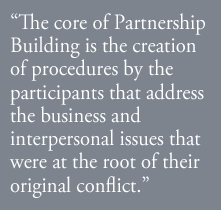
![]()
 Executives rely on partnerships to reach their goals. When these partnerships are eroded by conflict, a cycle of frustration and blaming leads to compromised productivity for both the individuals involved and the entire team, division, or organization. Negotiations may be deadlocked; difficult decisions may be ignored; and the tension between leaders may undermine the relationship between their respective workgroups. Often the parties lose sight of the concrete issues that initially triggered the conflict.
Executives rely on partnerships to reach their goals. When these partnerships are eroded by conflict, a cycle of frustration and blaming leads to compromised productivity for both the individuals involved and the entire team, division, or organization. Negotiations may be deadlocked; difficult decisions may be ignored; and the tension between leaders may undermine the relationship between their respective workgroups. Often the parties lose sight of the concrete issues that initially triggered the conflict.
A partnership characterized by long-standing conflict often requires a targeted intervention to bring about a lasting resolution. Issues-Based Partnership Building provides a structured conflict resolution process – one that combines elements of negotiation, problem solving, and team building - to help the participants regain perspective and negotiate mutually beneficial, collaborative working relationships. Partnership Building works with all parties involved in the conflict to improve their communication in the present and to build ongoing processes that reinforce their relationship and mutual productivity in the future.
![]()
While there is no "cookie cutter" approach to partnership building, our process usually incorporates a number of key elements:
Establishing performance objectives.
The facilitator helps the participants become aware of how much they rely on one another for personal and business success, and how their conflict has undermined both their individual productivity and their collaborative goals. The sponsoring manager - usually the participants' superior - also plays a critical role by delivering a clear message that the discord is taking a toll on their performance. Either the participants themselves, or their managers, identify building a productive partnership as a distinct performance objective for each of them.
 Using facilitative techniques to effect change.
Using facilitative techniques to effect change.
Partnership Building begins with a series of one-on-one meetings between the facilitator and each participant. The facilitator gains an understanding of the business issues and the unique concerns of each of the participants, enabling him to set the agenda for a series of joint meetings. These meetings are characterized by a structured agenda, strict ground rules, defined objectives, and active intervention.
Analyzing the business interface needs.
The facilitator investigates and analyzes the business interface between the participants, identifying friction points. This analysis is critical to resolving the underlying issues, since conflicts between interdependent executives often arise as a result of ambiguity around their responsibilities vis-à-vis mutual deliverables, and the lack of clear business processes that define how they and their respective teams work together.
Refocusing on legitimate issues.
Since the original sources of friction are often obscured, the facilitator works with the participants to assess the nature of their grievances. Participants distinguish inflammatory noise - statements made out of defensiveness and frustration - from legitimate issues - areas of mutual concern. By clearing the "noise" and focusing on legitimate issues, the real problems can be resolved.

The core of Partnership Building is the creation of procedures by the participants that address the business and interpersonal issues that were at the root of their original conflict. The participants rebuild their partnership as they redirect their energy towards solving their performance issues. Fueled by their success, they develop ongoing processes that guide how they will communicate, share information, make joint decisions, and resolve their differences.
Relying on processes to manage the relationship.
The Partnership Building process is complete once the participants are able to rely on the processes they have developed to manage their tasks and settle potential disputes.
Download a printable PDF of this page.
Back to top